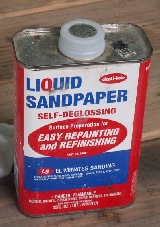 |
My #1 choice,
Liquid sandpaper or liquid sander.
In Canada it is not available at Home Depot and Rona. However, it is sold on-line at Home Hardware as "Liquid Sander" |
|
My #2 choice
Regular sandpaper
|
|
| TSP, although recommended by some, is not a good choice. It is excellent for cleaning surfaces prior to painting but not a good deglosser. |
|
| Liquid Sandpaper - Deglossers |
|
|
New paint will not bond to a glossy surface, no matter how clean it is. In order to make the paint stick to old glossy paint it is necessary to remove the outer layer of gloss from a previous painted surface, such as trim, baseboards and doors. By removing the gloss we create a coarse and rough surface necessary for a new coat of paint to bond. To remove the gloss we can use a liquid sandpaper or standard sandpaper. This product is also known as liquid sander and, more commonly, a deglosser.
- What is liquid sandpaper?
- What it doesn't do.
- Is trisodium phosphate (TSP) a good substitute?
- How is it applied?
- Why not use plain old sandpaper?
- Warning. Liquid sandpaper is toxic and flammable!
- Links to other helpful articles.
WHAT IS LIQUID SANDPAPER?
The name "liquid sandpaper" is a bit misleading because it is not sandpaper. It is a chemical mixture, strong solvents like naphtha, ethyl acetate and ethyl alcohol that removes the glossy layer from the old paint. Unlike regular sandpaper, it just removes the gloss and dulls the surface so there is a good bond between the old and new paint. It can not be used to smooth the surface like regular sandpaper. Liquid sandpaper is also referred to as deglosser and wet sanding. Deglossers are basically a weak version of paint stripper and work by softening the paint. Liquid sandpaper is ideal for removing paint from ornate objects that have grooves and intricate designs. Deglossers are easy to apply.
Liquid sandpaper can only be used on smooth surfaces and should not be used on engineered wood such as particle board and aspanite (OSB board). The moisture in the solution causes the board to swell.
WHAT IS DOESN'T DO
Liquid sandpaper doesn't work like standard sandpaper. It cannot make the surface smoother, it just removes the gloss from painted wood.
You still will need regular sandpaper to remove any irregularities.
IS TSP (TRI-SODIUM PHOSPHATE) A GOOD SUBSTITUDE?
Some sources state that TSP can be used as a deglosser but I disagree. TSP has some deglossing abilities but it does not give you the strong bond needed when painting over glossy surfaces. TSP is in essence a strong detergent and should not be used as a deglosser. However, it is a good product for cleaning and preparing a surface for painting.
APPLICATIONS
Just like for any other painting job around the house it is important to work on a clean surface. Before using liquid sandpaper all surfaces to be deglossed should be thoroughly cleaned and dried.
Use a lint-free soft cloth to apply liquid sandpaper. You do not have to apply a lot of pressure, a light rub to scuff up the surface will do it. Let it sit for a while. Check the product label for the manufacturer's recommended set time. Use a clean cloth to wipe off the residue. If necessary, change cloth often, do not let it get saturated with residue. That is all there is to it. You now have a surface that looks sanded but there is no sawdust to clean up. |
|
|
WHY NOT USE PLAIN OLD REGULAR SANDPAPER?
- It is physically a more demanding job.
- Time consuming and near impossible for use on some wood mouldings and ornate trim.
- There is more cleaning involved because of the sawdust generated.
- Oil based paint made and applied prior to the late 1970s contained lead. Lead was added to paint to speed up drying and to increase durability. Using sandpaper on older paint is a health hazard and could cause lead poisoning by inhaling toxic lead particles. For more information go to "lead".
WARNING. MOST DEGLOSSERS ARE TOXIC AND FLAMMABLE
When using deglossers adhere to the following!
- The work area should be well ventilated because the chemicals in liquid sandpaper give off strong and toxic fumes.
- Wear eye protection and gloves.
- Liquid sandpaper is also highly flammable. - Stay away from high heat or open flame. - If you work near the furnace and/or water heater tank, turn off the pilot light(s) and re-light after the area is free of all fumes.
- Used cloths can spontaneously combust and must be left out to dry (outside) before disposing of. |
LINKS TO OTHER HELPFUL ARTICLES
Oil or latex? How to test old paint. Advantages, disadvantages.
Tools and supplies. For surface preparation and painting.
Buy the right brush or roller. Bristles, roller material, nap length.
Surface preparation. Wallpaper glue. Treating mildew.
Painting tips. Getting ready. Tools. Painting. Storing paint.
Paint Tray Liners. Make your own. Do you really need one?
Clean-up time. Brushes, rollers, trays, solvents, paint disposal.
Lead in paint. Health warning. Remedial action. Government.
Lead. Sources of lead other than paint. Remedial actions. Health concerns.
|
|
|
|
|
Back to Top |
|